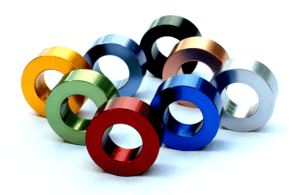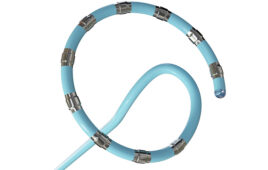High-performance aluminum anodic surface treatments offer medical device manufacturers greater options for sterilization-resilient medical devices.
Neel Patel, Florida Anodize System & Technologies

[Image from Florida Anodize System & Technologies]
What is it?
Aluminum anodizing is the process by which the surface layer of an aluminum substrate is electrochemically converted into an aluminum oxide layer. Although a natural oxide layer can be found on aluminum, this layer is uneven, thin and offers poor protection against chemical corrosion and wear abrasion and is wholly unsuitable in a medical environment.
The anodizing process allows aluminum components to have a uniform and regular surface layer, increasing component durability and protecting the underlying material from corrosion. Supplementary processes can add to the functionality of the anodic layer. For example, colorants, lubricants or even antimicrobial biocides can all be deposited into the anodic structure.
Anodic coating standards
While the concept of aluminum anodizing if fairly straightforward, various industry-dependent standards influence process parameters, which in turn, greatly affect final coating characteristics.
Among the most often-used standards, especially in the United States, are those developed by the U.S. Department of Defense, namely specification Mil-A-8625. Among the anodic coatings it details are Type I — Chromic acid anodizing, Type II — Sulfuric acid anodizing, and Type III — Sulfuric acid hardcoat anodizing.
The medical device industry has not developed its own, unique anodic coating standard, but instead relies upon the military specification with the most often used being Type II and Type III. While both offer protection, Type II coatings are generally more aesthetically pleasing, with Type III coatings having greater abrasion resistance at the cost of generally being less aesthetic.
Validation of effective aluminum anodic coatings
Even before COVID-19, the quest for effective sterilization — especially with a better understanding of hospital-acquired infections — led to the use of chemical sterilization processes that were quite corrosive to anodized aluminum. The color and anodic coating would quickly degrade after the first few sterilization cycles, thus decreasing the working life of an otherwise capable medical device.
However, anodic techniques have been specifically developed to overcome this weakness, enabling medical device manufacturers to continue to use aluminum as a primary component for their devices. To create durable, reusable medical devices, a medical anodize must be able to withstand at least 50 to 100 cycles of vaporized hydrogen peroxide or peracetic acid sterilization, or the use of a high-alkaline cleaner without significant loss of color or coating integrity. Anodic coating that cannot maintain this minimal level of resiliency should not be considered a valid or effective anodic treatment for medical devices.
Another important characteristic of an effective medical-grade anodic treatment is that it has a smooth and even finish without any local discoloration. Similarly, it should not appear dull or result in a grainy surface (unless that is the desired effect).
A smooth and even finish allows designers to have a blemish-free background for markings, and enables device marketers to speak to the quality of all aspects of the medical device. Notably, a consistent surface finish also indicates that the anodic coating was evenly applied to the substrate and that there are no weaknesses in the coating that could lead to accelerated corrosion and device failure.
Neel Patel is VP at Florida Anodize System & Technologies (FAST), an ISO 13485 provider of aluminum anodic coatings. He is the medical and surgical industry product line leader at FAST, specializing in anodic surface treatments designed to withstand surgical sterilization systems and surgical cleaners.
The opinions expressed in this blog post are the author’s only and do not necessarily reflect those of Medical Design and Outsourcing or its employees.




